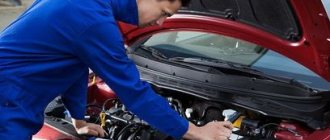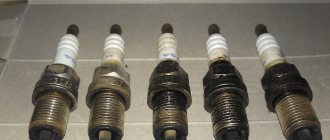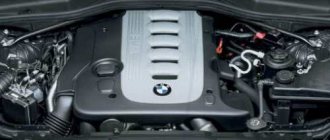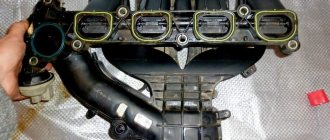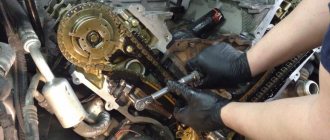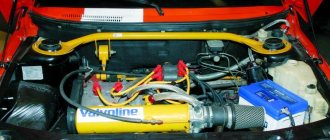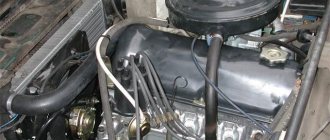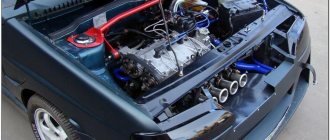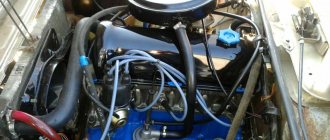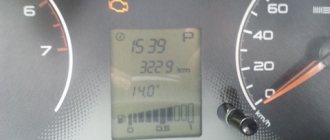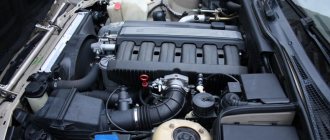Ignition timing failure
When it is impossible to determine the exact position of the inoperative cylinder, the ignition timing system should be checked.
In injection engines, the ignition is controlled by an electronic unit, so the correct operation of it can only be determined by computer diagnostics. You can continue troubleshooting by eliminating this cause.
The fuel mixture is prepared from gasoline and air. Their quantitative composition affects the operation of the Chevrolet Niva engine. The lack of air is usually due to a clogged air filter.
Excessive amounts indicate a “suction”. On this car, air leaks often occur at the attachment point of the vacuum brake booster pipe,
but don't forget about the throttle position sensor.
The mixture may be of poor quality due to clogged nozzles. Worn o-rings cause depressurization of the fuel system or air leaks. The solution to this situation is to replace the injector seals.
The car is shaking, what should I do?
At the first stage, the machine is diagnosed. Let's say that you have a Niva with a carburetor engine in your garage. Your car already shows signs of “illness” at the first stage of movement. Or the car started moving without any hassle, but when a certain number of revolutions was reached, the engine malfunctioned. All this will not give answers, but only creates questions, because anything can break. In any case, if unstable operation of the car’s power unit is noticed while pressing the accelerator pedal, the first thing you should do is:
- Check air and fuel filters. The supply of air and fuel to form a combustible mixture will be difficult if these elements are heavily contaminated.
- Check the fuel pump. Its incorrect operation leads to unstable fuel supply.
- Check fuel pressure. The supply of the fuel-air mixture under insufficient pressure often leads to jerking of the car. The pressure when the engine is running should not exceed 3 kgf/cm2.
Most of the reasons lie in the car's fuel system.
You shouldn’t write off the ignition system, and sometimes even the transmission can cause discomfort while driving. There can be many reasons. To narrow down your suspicions, measure the conditions during which the car begins to act up.
. To do this, while driving, watch the instrument panel and remember at what moment the uniform movement stopped. Do this several times to confirm that your observation is correct.
Steering gear
If the steering mechanism is faulty, a similar problem can also occur. If the steering rack has any malfunction, it can create jerks when starting. In this case, the worn parts of the rack are simply replaced, and the problem disappears.
Also, the steering rack tips may have strong play. As a result, during a sharp start or braking, or increase in speed, so-called steering wheel wobble may occur. Bent tie rods result in a sharp jerk of the steering wheel to one side when starting off. This problem requires a quick solution.
Other elements of the steering system, including bushings and silent blocks, can cause the car to knock and jerk when driving. All this applies to the steering mechanism - it can be the reason why, for example, a GAZelle car jerks when starting off. But GAZelle is not the only brand where such breakdowns occur.
Note that problems with the steering mechanism are easier to solve than problems with the automatic transmission. However, the steering mechanism requires urgent repair for the safety of the driver and passengers.
The opinion of car enthusiasts about the causes of engine tripping
1. It doesn’t troit, it just wobbles, or the reason is in the candle
“How it happened: I was coming from the Urals, there was little fuel, I filled Rosneft with 10 liters, and there were 20-25 in the tank. I continue to move at a speed of 140–150. The police stopped me, I slowed down and realized that the engine was stalling. I immediately realized that the gasoline was bad. I got home and refueled at a normal gas station. Nothing has changed, only the tremors have become stronger.
I started thinking like this: there was excessive oil consumption, the fourth cylinder was knocking, and I decided that the spark plug needed to be replaced. I didn’t go to the service center and decided to repair it myself.
After disassembling, I discovered that on the fourth one the armor wire was bad and the spark was weak.
The candles, naturally, were in terrible condition. On the fourth cylinder the spark plug is black and dirty, on the others it’s the same. Only on the second cylinder the spark plug is ok. I cleaned the dirt from the spark plugs, the contacts on the wires, and put them back. Now the engine no longer shakes.”
2. Diagnosis of engine tripping with your own hands
“If the engine is shaking at idle, check the spark plugs and coils.
Of course, anything can happen, the piston may burn out, then the engine not only stalls, but also smoke comes out. But first of all, we check the spark plugs and coils. One way or another, you can detect a faulty cylinder by looking at the spark plug.”
3. Even if the engine is running rough, repairs may take a minute
“Late in the evening I noticed that the engine was shaking while driving. I didn't check anything. The next day I drove 30 kilometers to the service station on 3 cylinders. There they began to find out which cylinder had failed. We dismantled the washer fluid reservoir, examined the coils, and noticed that the fourth cylinder chip had come off. We snapped it and now the engine doesn't start. The most important thing is that the error did not appear on the dashboard.”
4. Why the engine stalls: looking for the reason step by step
“If the engine stalls when starting, then follow the following sequence when checking the engine (2108–2120). It takes into account two characteristics: the likelihood of failure and ease of diagnosis.
- Check high voltage wires. It is better if you always have spare wires from the first spark plug with you; with its help, replacing them one by one, you can check the internal condition of the working wire.
- Check to see if the distributor and slider are working properly.
- Diagnose the spark plugs. Even if they cost different, the main thing is that they are in good working order, not dirty, and the gap is small. Haven't you changed the spark plugs in a while? This means that the reason that the engine is tripping is because of them. It is better to carry a spare spark plug with you; with its help you can check the others, replacing them one by one.
- Check the condition of the ignition system connector contacts. We remove the connectors, Hall sensors, switch, after checking, do not forget to install them in place. Sometimes this will be enough for tripling to go away.
- Check to see if the low voltage wire connection on the ignition coil is bad. There should be no contamination on contacts “B” and “K”; they must be tightened. It is recommended to unscrew them, lubricate them and put them in place. One car owner dealt with dampness this way: he wrapped the reel with film. You shouldn't do this. When the coil is reinstalled higher from the factory location, it is necessary to check the grounding.
- Look at the condition of the battery terminals, ignition system power wiring, and engine grounding. If this is the reason, then the starter may also not work.
If, after such a diagnosis, the reason why the engine is tripping is not found, we proceed to check the carburetor and compression.”
5. Is the engine trouble? We change service stations
“I noticed that the engine in my car was shaking. The problem arose after the valves were adjusted. But I didn’t immediately understand why tripling appeared.
After some time, the reason was finally found. It turned out that the thermal gap on the intake valve was too large. This is how cool the masters adjusted them. That is, the valve opened over a shorter distance, and the filling of the cylinder was insufficient compared to others.
However, this happens, of course, infrequently, just like loss of compression on one of the cylinders.”
Blocking. Doesn't work without blocking. Blocking problems.
Re: Blocking. Doesn't work without blocking. Problems with blocking
Post by KYSYA » May 22, 2014, 4:29 pm
I read that people don’t turn on the lock.. I have the opposite problem..
The vibration lock turns on itself. I drive and drive and the lamp starts to light up and the sound changes to a hum. I push the lever back while moving - it saves me for a minute or two... Has anyone encountered this?)
Yes, and it also started to knock out second gear (maybe the problem is not from here)
Re: Blocking. Doesn't work without blocking. Problems with blocking
Post by PaukReal » May 22, 2014, 9:34 pm
Re: Blocking. Doesn't work without blocking. Problems with blocking
Post by KYSYA » May 23, 2014, 08:29
Re: Blocking. Doesn't work without blocking. Problems with blocking
Post by Serg548 » 02 Jun 2014, 13:29
Hello, friends! The following problem appeared - when the lock is turned on, when driving with the wheels turned out and starting, an unpleasant, sort of impact sound is heard in the transfer case area (as if there is no tooth on one of the gears).
When driving in a straight line everything is quiet and beautiful. When the lock is turned off, is everything normal when turning and straight? What could this be, friends?
Added after 2 hours 51 minutes 20 seconds: Re: Blocking. Doesn't work without blocking. Blocking problems. I'll get better guys. Today I noticed that when starting hard, with the wheels turned (without blocking), something also passes through the cardan to the transfer case.
I'm starting to lean towards the death of the front differential. Who thinks what, friends.
NIVA car owners community forum
- Unanswered topics
- Active topics
- Search
Why does the engine start to stall?
Let's start with the fact that engine tripping is a violation of the combustion of the mixture in the cylinders, which is accompanied by a clear increase in vibration
Please note that the appearance of internal combustion engine vibrations is not necessarily a tripping, since there are a number of other reasons why the engine vibrates strongly
The list of main faults that cause the engine to stall includes:
- supply of insufficient or excess fuel to the cylinder;
- supply of insufficient or excess air;
- malfunction of the ignition system, early or late ignition;
- wear or breakdown of the motor, which is accompanied by a decrease in compression;
In other words, the engine begins to stall as a result of an inappropriate composition of the fuel-air mixture, untimely ignition of the mixture or inability to ignite the charge, as well as violation of the conditions for normal combustion of the mixture as a result of mechanical wear or breakdown of the engine itself.
Based on this data, you can narrow your search and the number of systems for diagnosis. The check should begin with the fuel system and injector, then the intake air supply and the ignition system are checked. In some cases, engine stalling may also be the result of a failure of one of the ECM sensors.
5.1.6 The car moves jerkily
Necessary explanation:
— jerk
— short-term spontaneous change in engine speed regardless of the position of the gas pedal. In everyday use, as a rule, there are a series of jerks; - failure
— noticeable delay in the engine response to pressing the gas pedal. Approximately can be considered as a limiting case of a jerk.
Conventionally, three types of jerks can be distinguished:
- at the moment of starting movement; — during acceleration; — with steady motion, i.e. with the gas pedal in constant position.
Warning
When using the DAAZ Solex carburetor, a very unpleasant defect occurs: when you press the gas pedal, a strong dip occurs, the engine stalls, and often there is no idle speed. Movement is only possible when the gas pedal is pressed to the floor, or you have to continuously “pump” the pedal. The reason is clogging of the fuel nozzle of the main metering system of the first chamber.
For an experienced car enthusiast
it is necessary to remove the top cover of the carburetor, as described above, unscrew the two air jets, use a thin screwdriver to unscrew the two fuel jets and remove them from the wells with a long wooden toothpick or a pointed stick. Do not mix up the jets when reinstalling them!
Then, use a syringe or a clean, lint-free cloth to remove gasoline from the float chamber and blow out the carburetor with compressed air, especially carefully - the fuel nozzle wells.
For an inexperienced car enthusiast
It is better to immediately contact a car service center. To get to the service center, cut off a piece of vinyl chloride tube 1–1.5 cm long (at least from the windshield washer tubes) and place it on the thrust lever of the second chamber drive. The engine speed will be approximately 2000 rpm. Use the clutch and brake pedals to maintain a safe speed.
Jerking when starting to move
At the moment the movement begins, the limiting case of a jerk—failure—occurs more often. The most unpleasant sensations are associated precisely with the delay in the engine’s response to pressing the gas pedal. Sometimes the engine even stalls.
The cause of failure may be either a malfunction of the carburetor accelerator pump or a malfunction of the vacuum corrector of the ignition distributor.
For work you need: wrenches “8” and “10”, Phillips and slotted screwdrivers, a clean rag, a piece of thin copper wire without insulation with a diameter of less than 0.3 mm, a compressor, a can of wd40 type liquid, possibly a portable lamp.
PERFORMANCE ORDER Jerking during acceleration The cause of jerking may be a low fuel level or a clogged fuel filter in the carburetor, a malfunction of the fuel pump or a clogged additional fuel filter, or a malfunction of the ignition system. For work you need: wrenches “8”, “10” and “13”, Phillips and slotted screwdrivers, a clean rag, a piece of thin copper wire without insulation with a diameter of less than 0.3 mm, a compressor, a can of wd40 type liquid, possibly - portable lamp. PERFORMANCE ORDER Jerks during steady motion Such jerks are most often caused by a malfunction of the ignition system. Diagnostics is required, contact a car service. The only thing you can try to do yourself: - carefully inspect the engine compartment. Turn off the ignition and check the secure fastening and seating of all wires and connectors at the switch, coil and ignition distributor. Start the engine and listen to its operation - the crackling sound when the high voltage breaks down to ground is weak, but distinct. In complete darkness, the spark during breakdown is clearly visible; - replace spark plugs regardless of their condition and mileage
Pay attention to the condition of the spark plugs - if it is abnormal, you may have to contact a car service
Other defects
Other reasons include low-quality fuel. When pouring low-quality fuel, which is very different from the previous one, you may feel a drop in power or a “stutter” when you press the gas pedal. If everything was fine, and then you went to a gas station where you had not been before, and it was after that that problems began, then the conclusion is obvious. This problem is very common for gas vehicles.
Almost every driver has encountered such an unpleasant situation when the car began to twitch during acceleration, at low speed, or even at the very beginning of movement. Experienced car enthusiasts say with confidence that such a problem can happen to any car, regardless of age and make. Jerks in motion can be observed both in the Chevrolet Niva and in any other car. If your car begins to jerk while driving, it is recommended to find the cause as quickly as possible and eliminate it in time.
Often, every driver can eliminate such an ailment without the help of specialists at a service station. Ignoring the problem can not only aggravate the situation, which will subsequently require expensive repairs, but also jerking the vehicle often leads to an accident. A faulty car is unable to start a smooth ride and then accelerate. A jerking vehicle not only instills fear and terror on other road users, but also knocks them out of the way. Next, let's try to figure out what can cause the uneven running of the car.
Engine
It’s worth revealing the most important point right away: the unit installed on this SUV does not work at all. The Chevrolet Niva is designed for increased cross-country ability, but the power of the 80-liter 1.7 engine is not enough. Therefore, do not expect much agility from this car.
If you also turn on the air conditioning while driving, cyclists will begin to overtake you. In addition, this device significantly increases gasoline consumption.
Forget about maneuverability when overtaking, as this car doesn't like hard acceleration and resists.
Permanent all-wheel drive is only appropriate on country roads.
Problems with the Republic of Kazakhstan (distributor)
Reg.: 02.21.2005 Threads / Messages: 12 / 806 From: Kiev, Ukraine Age: 20 Car: VAZ-2121, 82
Reg.: 12/06/2004 Threads / Messages: 628 / 51730
yeah, he's the one. Expensive thing
Added after 2 minutes 24 seconds:
a new one costs 7 thousand. Will it be better than a well-capitalized one?
Reg.: 02.21.2005 Threads / Messages: 12 / 806 From: Kiev, Ukraine Age: 20 Car: VAZ-2121, 82
Reg.: 12/06/2004 Threads / Messages: 628 / 51730
Reg.: 12/06/2004 Threads / Messages: 4029 / 23189 From: Moscow Age: 66 Car: 21214M, 2013
Alexey aka ALER.
Reg.: 12/06/2004 Threads / Messages: 628 / 51730
Reg.: 12/06/2004 Threads / Messages: 4029 / 23189 From: Moscow Age: 66 Car: 21214M, 2013
It can’t be. Maybe it’s still a high-low burp?
If the car does not move without blocking, something is wrong with one of the axles or drives.
Alexey aka ALER.
Reg.: 12/06/2004 Threads / Messages: 628 / 51730
namely the locking lever. I'm shocked. if there was something with the axles/cardans/splines, as I understand it, it simply wouldn’t go, but when I press the lever, it goes. Well, I’m telling the truth, I may be crazy, but this is the handle closest to the dashboard,
What are the dangers of operating a vehicle that is tripping?
As soon as the car is repaired, novice drivers have a question: is it possible to drive with this malfunction, and for how long? If you don’t care, you don’t want to extend the life of the engine, and you don’t feel discomfort from its improper operation - you can drive until the car stops starting. Of course, the engine tripping when cold, disappearing after reaching operating temperature, is not an emergency mode, but it also accelerates its wear. This is the first, still “light” signal that “something has gone wrong,” which is always easier to fix than to repair the result of a worsening defect.
The nature of the breakdowns due to cold trim depends on the reason for the incorrect operation of the motor.
Troubling due to air leaks or depletion of the mixture (injector) provokes overheating. Due to friction associated with a missed flash in the cylinder, unburnt fuel washes away the oil film from its walls, causing sticking, and partially enters the engine oil, worsening its properties.
The gasoline-oil mixture also “throws” the spark plug electrode, making it difficult to self-clean and further spark formation.
Unburned (or incompletely burned) fuel, entering the vehicle's exhaust manifold, contaminates the catalyst (or DPF filter, if we are talking about a diesel engine), accelerating the need to burn it. It’s difficult to do this in the “pulling” city mode, so the “cat” gets clogged, heats up, burns out and collapses faster. This malfunction will definitely cause errors in the lambdas, and perhaps something more serious (depending on the age of the car).
Ignition timing failure
When it is impossible to determine the exact position of the inoperative cylinder, the ignition timing system should be checked. In injection engines, the ignition is controlled by an electronic unit,
therefore, the correctness of its operation can only be determined by computer diagnostics. You can continue troubleshooting by eliminating this cause.
Mix quality
The fuel mixture is prepared from gasoline and air. Their quantitative composition affects the operation of the Chevrolet Niva engine. The lack of air is usually due to a clogged air filter.
Excessive amounts indicate a “suction”. On this car, air leaks often occur at the attachment point of the vacuum brake booster pipe,
The mixture may be of poor quality due to clogged nozzles. Worn o-rings cause depressurization of the fuel system or air leaks. The solution to this situation is to replace the injector seals.
Also interesting: Tuning for Niva
How to enable blocking
It's quite easy to do. On the Lada 4x4 car there are three levers to the right of the driver, we are interested in the smallest one. When the driver moves it back, the lock on the Niva 2121 works; as soon as the driver moves the handle forward, the mode will turn off. It is best to carry out all manipulations while the vehicle is stationary.
Experienced drivers know that the lock does not always turn on (off) the first time. The fact is that the shafts may not be in the right position or they may “bite” if additional force is applied to the coupling (for example, the car has stopped while turning). Then you need to drive forward or backward a little, align the wheels and try again. As a rule, in this case everything turns on.
On the Chevrolet Niva, this procedure is performed differently. There are not two levers to control the transfer case modes, but one. The one we need is located closer to the driver. Although the locks on the Niva-Chevrolet, as well as on the Lada 4x4, work in the same way, they are activated differently. On a Chevrolet, to do this, the transfer case mode control lever must be moved with the clutch depressed while the car is stationary to the left (towards you). To disable the blocking, go in the opposite direction.
About the power unit of the model
This VAZ 2123 model is equipped with a Chevrolet Niva engine of an improved design. First of all, car owners note a noticeable reduction in noise from the power unit. This was achieved through the use of a hydraulic tensioner mechanism for timing chains. The Chevy Niva engine is a traditional design with a vertical arrangement of four cylinders. The electronic engine management system controls fuel injection into the combustion chambers of the engine.
Some changes took place in the timing drive; the chain began to be installed as a single-row one, and this entailed the installation of new gears, which also have one row of teeth. Another innovation of this engine was the use of sensors that began to monitor detonation. These and other innovations allowed the developers to obtain a power unit that fully complies with the European standard EURO 2, which regulates emissions of toxic substances from exhaust gases. Let us consider in more detail the description of the car and its power unit.
About the transmission
First of all, a few words about the structure of the Niva. It has permanent all-wheel drive. What does it mean? It's simple - torque is simultaneously transmitted to four wheels. This is one of the fundamental differences between the Niva and other cars. They supply torque to only one of the axles (front or rear).
All-wheel drive is implemented through the use of a transfer case. The torque, having passed through the gearbox, goes to the transfer case, and from it to the front and rear axles. This design makes it possible to create a locking center differential on the Niva, which, together with all-wheel drive, provides it with increased cross-country ability. Here it is necessary to say a few words about the differential. Largely thanks to him, the excellent off-road characteristics of the Niva are realized.
No compression
The most unpleasant reason is a decrease in compression in one of the cylinders.
This problem can only be identified and fixed in a professional workshop:
- valve burnout - the pressure decreases due to a leaky fit of the valve to the seat;
- failure of hydraulic compensators - when they jam, the valves can “hang”, which is why compression decreases;
- wear of the cylinder-piston group is determined by a special tool that measures the gap between the cylinder and piston rings.
Compression can only be restored in a specialized car service center that has the appropriate equipment. To decide whether you need to go to a specialist, it is better to measure the indicator in advance using a compression meter.
Problems in the injector
We will consider injector malfunctions associated with engine tripping using the Lada engine as an example. In this case, the most likely cause is the injectors. Clogging of one of the parts can lead to an imbalance in the air-fuel mixture. This effect is called a “lean” mixture, since there is not enough fuel for normal ignition. It is for this reason that the VAZ engine (injector) is tripping.
To fix the problem, you need to dismantle the car's injectors and carry out diagnostics using a special stand that will show which part has failed. You can do the diagnostic operation yourself. To do this, you will have to remove the fuel rail, but do not disconnect it from the power system. After turning on the fuel supply pump, you will see which of the injectors is spraying fuel incorrectly. Thus, having identified the faulty element, it is worth replacing it and eliminating the reason why the VAZ engine stalls when hot.
External and internal CV joints
If some suspension parts are poorly secured, then when driving (especially during a sharp start), they can cause the car to jerk. First of all, you need to check the inner and outer CV joints. The inner CV joint transmits rotational energy from the gearbox to the axle shafts and then to the wheels. This element is quite important, and if problems arise with it, it must be changed. This can be done at any service station. Features of failure of the inner CV joint are as follows:
If your VAZ car jerks when starting from a stop, then first of all you need to check the CV joints. Often on forums when discussing a similar problem, users point to this particular node. Considering the prevalence of these cars and the cheapness of spare parts, repairing this element is unlikely to be expensive.
You will be very lucky if the problem turns out to be in the car's CV joints. These are inexpensive items that are easy to replace. It is much worse if a fault is discovered in the gearbox.
Niva injector jerks when driving
Elimination of jerks while driving, injector
The car jerks when driving
Self-diagnosis Niva Chevrolet, replacing the idle speed sensor
The car jerks when moving. Several reasons.
The revs fluctuate, the car does not pull and jerks for the reason.
Chevrolet Niva (NIVA Chevrolet). The check is on. Do-it-yourself engine diagnostics.
Chevrolet Niva (shniva). clutch problem!
The Chevrolet Niva can't handle it. Doesn't develop speed
Sometimes it twitches, sometimes it doesn’t twitch. Diagnostics and repair of VAZ 2112
Top 7 reasons why the engine stalls, and what to do if it stalls? Simple verification methods
Are the rust stains gone? There’s one more thing you need to do - find where they still measure the biofield with a special device and check to see if your karma is all-wheel drive. Nothing personal.
:And many people are annoyed by these problems every day, and without specific knowledge on setting up and repairing the carb, etc., you can spend a very long time looking for the cause of the problems. ***It’s a heartbreaking sight - the problem annoys me every day, but no knowledge is gained on how to solve it (at least the knowledge of who and how can solve this problem for money)
:And I think it’s ugly to be ironic on this topic, and I think many will agree with me. ***Oleg! and I consider a lot of things “ugly”, including retelling other people’s nonsense, what’s next?? and now about the incomprehensible: almost every quote I gave is a self-sufficient pearl, is it really necessary to comment? or seriously discuss adjustment using a gasket, the pressure developed by the pump is from 0.9 to 2.5 (!) atm. (it was these numbers that amused me the most) And “. Uncle Vasya by ear and eye. for 3 bottles of beer. “—this is generally a classic.
Konstantin. PS I repeat - nothing personal
and I also really want to know what “special service” is.
Folks, who can tell me what kind of bullshit it twitches when driving, I don’t know what to do, I cleaned the carb, I thought it was the engine, I did a thorough overhaul, the valve burned out, but it’s still just such bullshit! I don’t know what to do with the throttle cable? Or I don’t know...
look at the ignition, if you checked something else
Yes, everything is fine in the ignition too
Maybe the filters are already clogged? or does the head cutter make?
I changed all the new filters, what kind of cut-off device is that?
the cut-off valve is also the solenoid valve of the carburetor, idle speed directly depends on it
it was checked at a car service, the normal speeds do not float, for example, from 800 to 900, but here I am driving, for example, I have 2000 revolutions and they start to hover from 200 to 3000, and the car jerks, then I drop the gas to neutral and put it in, it doesn’t jerk, I start again Press the gas and it jerks again
there could be many reasons for this. In addition to everything listed, it can also be a clutch fork, or even an engine mount.
Yes, the clutch has nothing to do with it, it seems, it’s probably in the carb? Who else thinks?
it was like that on the spear, but I just adjusted the ignition timing and everything is fine
I installed it earlier and later, still the same
At least I took a video, since I checked everything and there’s no way to cure it
change the spark plugs and wires, and check for antifreeze getting into the cylinders
I changed the spark plugs, I didn’t change the high-voltage wires, do you think it’s because of them? Antifreeze does not get into the cylinders, this is 100%
what kind of candles did you put in?
Bosch Platinum, before them there was the same garbage
that's what I thought) throw them away))) and install Brisk
fucking candles, brisk shit
awesome because they cost a lot or what?
because they are high quality
and you find a stand for checking spark plugs and check under a pressure of 10 atm. Brisk and Bosch Platinum, then you’ll write which ones are quality)))
NGK spark plugs aren't bad either! many people praise them
actually, it’s not about the spark plugs, most likely, you need to dig a little deeper_ here’s some information about the carb—— Most often, jerking and twitching while driving with the gas pedal held in one position cause malfunctions in the ignition system.
The carburetor can be the cause of jerking only when several droplets of water or small debris are found at the bottom of the float chamber, which sometimes comes close to the fuel nozzle of the main metering system and, blocking the passage of gasoline, can cause irregular but very sharp jerks, up to complete stop of the engine. If jerking occurs only when the gas pedal is pressed, this indicates a clogged accelerator pump.
To distinguish malfunctions of the ignition system from malfunctions of the fuel system, you need to hold the gas pedal in one position during the test diagnostic trip and select a section of the road with a long uphill climb for such a check.
Broken high-voltage wires or capacitor
In the event of a breakdown of high-voltage wires, the engine, as in the previous case, usually stalls when cold. After warming up, the problem either disappears completely or becomes less pronounced. Strong shaking of the engine when hot usually indicates other problems.
The easiest way to determine the breakdown of high-voltage wires or a capacitor is to observe them in complete darkness with the engine running. Sparks indicate a breakdown. You can replace the capacitor and wires, completely or partially. You can also check the serviceability of high-voltage wires by measuring their resistance using a multimeter. For a normal wire it does not exceed 20 kOhm. You should also remember that it depends on the length of the wire, so it will be different for every wire.
When visually inspecting wires, you need to pay special attention to their tips. They should be plain, without a light gray coating inside and without gray-brown dots outside.
Causes of carburetor engine tripping
If the engine of a VAZ 2110 8-valve carburetor fails, then the reasons are as follows:
- Setting the quantity and quality of the mixture. The carburetor has mixture quantity and quality screws that need to be adjusted.
- If the engine of a VAZ 2110 fails, the reasons lie in clogged jets and idle channels.
- The gasket that allows air to pass through is broken. This makes the combustible mixture leaner.
- When the VAZ 2110 engine stalls, the cause may be a malfunction of the carburetor magnetic valve.
- The float system is not adjusted correctly. As a result, the fuel level decreases. This leads to the fact that the engine on the VAZ 2110 8 valves will operate unstably.
- The filters that allow gasoline to pass through are clogged.
- The ignition system distributor is malfunctioning.
If the engine in a VAZ fails, then you should start by checking the spark plugs. Most often the reason is their contamination. If this does not bring results, then you need to start looking for more serious reasons.
VAZ tachometer connection diagram
The first car from the Zhiguli family equipped with a tachometer was the VAZ 2103. Neither 2101 nor 2102 had such a device. The tachometer is used to measure the crankshaft speed. It is a revolution counter, showing their number by deflecting the scale needle to a certain angle. The tachometer is also indispensable when setting up the carburetor - its indicators are taken into account when adjusting the idle speed and the quality of the fuel mixture.
VAZ-2106 tachometer connection diagram
The “Sixes” were equipped with a tachometer model TX-193. This tachometer consists of:
- plastic cylindrical body with glass holder;
- a scale divided into zones of safe and dangerous modes;
- backlight lamps;
- a milliammeter with an arrow attached to its shaft;
- electronic printed circuit board.
The principle of its operation is based on measuring the number of electric current pulses in the primary (low-voltage) circuit of the car’s ignition system. In the VAZ 2106 engine, for one revolution of the distributor shaft, corresponding to two rotations of the crankshaft, the contacts in the breaker close and open exactly four times.
These pulses are removed by the device from the final terminal of the primary winding of the ignition coil. Passing through the parts of the electronic board, their shape is converted from sinusoidal to rectangular, having a constant amplitude. From the board, the current flows to the winding of the milliammeter, where, depending on the pulse repetition rate, it increases or decreases.
The arrow of the device reacts precisely to these changes. The greater the current, the more the arrow deviates to the right and vice versa.
Connecting a tachometer in carburetor VAZ 2106
Electric circuit of the speed counter of the carburetor “six”
In a contactless ignition system, the tachometer is connected not to the coil, but to the switch
Connecting a tachometer in injection VAZs
It should be taken into account that the colors of the wires and their purpose may differ depending on the manufacturer of the device, but for the standard “TX-193” device, which is usually used in “sixes”, the diagram is as follows:
- A white cable is required to connect the backlight.
- The red wire is connected to the ignition switch, a fuse is used for this, this cable supplies power when the ignition is activated.
- A white cable with a black break is required for connection to the car body.
- The brown wire connects to the K+ terminal on the coil.
- The black wire is connected to the charging current indicator relay. The latter, in turn, is installed on the right in the engine compartment.
- The gray-black cable is required to connect to the engine fluid pressure regulator installed to the left of the engine.
Connection diagram for tachometer VAZ-2108 and 2109
Let us immediately note that the fuel supply system – injector or carburetor – does not play a special role here. As you know, currently the most common are cars with the following engine types: gasoline or diesel.
Depending on this, the tachometer is selected, unless, of course, it comes in the stock version. The thing is that on gasoline engines the tachometer reads data from the ignition coil, or rather, the impulses that arise here. However, the design of diesel power plants does not provide for this unit.
Accordingly, here the tachometer reads pulses not from the ignition coil (for lack of one), but from the generator.
The first two wires (12-volt and Signal) are to contacts “B” and “K” of the ignition coil, respectively. All that remains is to secure the mass in any convenient place.
Useful: Overcurrent protection circuit breaker
VAZ-2110 tachometer connection diagram
- tachometer VAZ;
- trip computer;
- ECM;
- crankshaft position sensor;
- ignition module.
Tachometer VAZ 2110 - with four outputs: if it is on a car with injection, it is connected not to the ignition (input 2), but to the ECM controller with an additional output provided for this (input 1) - and in this case it reads the number of revolution pulses directly from the controller. It receives a signal about the position of the shaft.
Schematic diagram of the tachometer electronics
Connecting modern electronic tachometers:
A tachometer designed for a 4-cylinder engine cannot be installed on another, because the readings will be false. Therefore, select a tachometer in accordance with the make of the car and the number of cylinders.
About the DPKV tachometer sensor
The tachometer has a sensor (crankshaft position sensor - DPKV). This device serves not only to count crankshaft revolutions, but also to determine its position at a certain moment, which is necessary for the electronic control unit to ensure proper operation of the power unit. When a metal object passes near the sensor core, an electrical impulse is generated in it, which is transmitted to the electronic engine control unit. The role of such an object in the power unit of a car is played by the crankshaft gear.
Shnivy's engine is shaking when cold
- Registration
- Entrance
- To the beginning of the forum
- Forum Rules
- Old design
- FAQ
- Search
- Users
And another request, before the malfunction appeared, did anyone tinker with the engine - did they take it apart, maybe for some reason?
Shniv’s father has a 2006 1.7, he complains that it starts to burn in the morning when it’s cold, Jackie Chan lights up on the factory spark plugs, he installed platinum ones - it became more or less fine, but in the morning it adjusts, I wonder where to look.
if there were long trips, say to Moscow and back, the exhaust valves could “fry”
I have the same problem with the Chevy, it goes up to 50 degrees when cold, I changed everything: module, spark plugs, wires, cleaned the injectors. Or it may be due to the module connection sensor. Tell me what other options are there.
What is a module connection sensor?
There were many, many Sheviks and 2114s with injectors repeatedly cleaned, spark plugs and explosive wires, ignition modules, etc. replaced 77 times. Most often, the problem was faulty, “clamped” hydraulic compensators. It's just that the exhaust valves warm up and lengthen faster than the head. issue the valve may open slightly. While there the antifreeze warms up. Advice for you. Check hydraulic compensators. The symptoms are not good.
It happens less often due to different injector performance. It’s not a fact that they were cleared. We usually work with such symptoms for sure. Force. We remove and check the performance of everyone. Then ultrasound and washing, and after washing, checking again. Sometimes we reject them. Positive washing result approx. 50%.
Jackie Chan lit up the factory spark plugs, put in platinum ones - it became more or less, but in the morning it adjusts, I wonder where to look. Thank you. ============= Well, since you forgot about the guarantee, then put the BC in the car, especially since Jackie-chan was blinking, it’s possible to count the error as stupidly the ignition module. the brain is being eaten away. They tell you about hydraulics here... I don’t know, I haven’t encountered it, although it’s quite possible. How long has the car run?
On the Mitsu Galante, the hydraulics were cured without removing them from the pihl. just poured in the slurry “high-gear slow flush” (precisely slow because all the other 5 minutes are poop) act strictly according to the instructions (it’s written on the jar). Also, the “high-gear” slurry is a good treatment for automatic transmissions
How long has the car run?
48k, now everything seems to be normal, my father changed the gas station, he says it’s getting better ============== it’s clear, but it’s still better not to put off solving the problem
to begin with: 1. measure the compression 2. set the BC to count errors 3. check the pressure in the rail
Well, then think about the measurement results
Most often, the problem was faulty, “clamped” hydraulic compensators. It's just that the exhaust valves warm up and lengthen faster than the head. issue the valve may open slightly. While there the antifreeze warms up. Advice for you. Check hydraulic lifters
What causes the car to jerk when running at low speeds?
Since the car begins to twitch when reaching even low speeds, it will not be possible to immediately identify one specific problem. Problems may be hidden:
- In the engine fuel mixture supply system;
- In the vehicle ignition system;
- At the checkpoint;
- In the distributor design;
- Includes fuel filters;
- In the sparking system;
- In the control unit of the vehicle's on-board computer.
Let's go through the faults in each of the listed systems in detail.
Checking the engine fuel mixture supply system
Often the reason that the car jerks at low speeds is due to a malfunction of the power system. When the car starts to move, the cylinders simply cannot receive the required amount of fuel mixture, as a result of which the car is unable to transfer the required amount of power to the chassis for smooth driving and smooth commissioning of the transmission. As a result of increased pressure and transmission resistance, uneven running of the machine appears.
To solve this problem, it is recommended that you first pay attention to checking the throttle body. It also wouldn’t hurt to test and diagnose the performance of the sensors installed in the system for determining idle speed indicators.
Do not forget to check the serviceability of the throttle valve position and the mass air flow sensor.
The car jerks - causes and solutions
The reasons why a Niva may twitch while driving can be different. And for the rather considerable mileage that I had to cover over several years, not only on the Niva, but also on other domestic cars, I can highlight the problems that made the car twitch when driving.
I want to say right away that the list below will probably not be complete and many VAZ 2121 owners will be able to give their thoughts on this matter. But personally in my practice I have only encountered the following:
About the Chevrolet Niva car engine
Many regions of the Russian Federation and most CIS countries have areas with road conditions where it is impossible to do without a high-quality SUV. It was for such conditions that AVTOVAZ developed and launched the Chevrolet Niva, which has proven itself when used in difficult road conditions. Buyers saw the first samples of this machine in 2002, although the design documentation was ready several years earlier.
The new development was supposed to be a replacement for the Niva 2121, which had been rolling off the production line for several decades. The financial crisis in the country did not allow the launch of the new model, so the license was sold to General Motors. Its specialists made a number of changes and improvements, after which the production of a new car began. A few years later, the model underwent restyling, which changed the appearance of the car, making it more modern and attractive.
The engine jerks (shuts up slightly) - View topic :: avtoremont13.ru
Novaya Niva, VAZ 21214m triples, doubles. The cause has been determined.
The sensor is not dismountable and therefore cannot be repaired. Jerking during steady motion Such jerking is most often caused by a malfunction of the ignition system.
In everyday use, as a rule, there are a series of jerks.
Sometimes the engine even stalls.
Check the pipes, determine if there is any depressurization of the system. If the indicator does not correspond to the norm, then further search for the cause should be sought in the pressure regulator, fuel pump. These actions must be performed not only with the carburetor system, but also with the injection system.
If an injector is installed on the Niva, then in this version the ignition system is also connected. The cause of the car jerking can be absolutely any sensor that has failed. Perhaps in this case you will need the help of specialists, because all the work is complicated by the presence of an electronic unit.
Eliminating jerking when accelerating a car If the Niva begins to jerk when accelerating, then in this case it is necessary to carefully check the engine power system. The driver presses the speed pedal while driving, but the vehicle does not accelerate.
By pressing the accelerator pedal, the driver provokes an increase in the amount of fuel mixture supplied to the cylinders.
The car jerks when driving
If this does not happen, breakdowns occur in a uniform manner. The carburetor engine has filters. We will not take into account the mesh in the neck, since it can only prevent the penetration of large particles.
You should carefully check the filter that goes to the fuel pump. In everyday use, as a rule, there are a series of jerks.
The extreme case of a jerk is a failure, a noticeable delay in the engine's response to pressing the accelerator pedal. Conventionally, three types of jerks can be distinguished: To determine the causes of jerks when driving a car with an injection engine, special diagnostic equipment is required, so in this case we recommend contacting a car service center that specializes in repairing fuel injection systems.
If you have some skills, you can identify the cause of jerking yourself. Jerk at the moment of the beginning of the movement At the moment of the beginning of the movement, the limiting case of a jerk—failure—occurs more often.
Turn off the ignition and check the secure fastening and seating of all wires and connectors at the ignition module and high-voltage wires. In complete darkness, the spark during breakdown is clearly visible; - replace spark plugs regardless of their condition and mileage
Pay attention to the condition of the spark plugs - if they are abnormal, the engine or its systems may need to be repaired
A specific cause of jerking during steady motion of a car with an injection engine may be damage to the throttle position sensor.
Additional symptoms confirming the malfunction of this sensor are: The sensor is not dismountable and therefore cannot be repaired. If a sensor malfunction is detected, see
If you have some skills, you can identify the cause of jerking yourself. Jerk at the moment the Chevrolet Niva begins to move. At the moment the movement begins, the extreme case of a jerk—failure—occurs more often.
Sometimes the engine even stalls. A jerk occurs when the Niva Chevrolet throttle valve begins to open, when, based on a signal from the throttle position sensor, the ECU determines the moment of transition from idle mode to load mode and must increase the amount of fuel supplied through the injectors. If the pressure in the fuel line is insufficient, even with increasing injection duration, there is not enough fuel for a smooth start.
NIVA car owners community forum
- Unanswered topics
- Active topics
- Search
The car jerks - causes and solutions
The reasons why a Niva may twitch while driving can be different. And for the rather considerable mileage that I had to cover over several years, not only on the Niva, but also on other domestic cars, I can highlight the problems that made the car twitch when driving.
I want to say right away that the list below will probably not be complete and many VAZ 2121 owners will be able to give their thoughts on this matter. But personally in my practice I have only encountered the following:
That’s probably all that I was able to remember from my personal experience in operating a Niva car and other Zhiguli models. At least there were no other symptoms with my cars. Maybe one of the owners will give their useful advice and problems that arose for them. If you have anything to add, you can add your comments below.
Source
Why does the engine bleed on gasoline?
Unstable engine operation when cold in injection engines is most often associated with a malfunction of the fuel system. Having determined which cylinder is firing, you need to evaluate the performance and spray pattern of its injectors. If you cannot do this, at least check (with a multimeter) that the voltage supplied to it is normal for a particular model. The next possible source of problems on gasoline engines with common rail are the pressure valve and booster pump. In addition, check the condition of the fuel filter (condensation may have accumulated in it).
Fuel filter
Checking the fuel filter
Ignition system
Shaking when cold after starting rarely occurs due to a failure of the ignition coil (individual module). Its malfunction usually occurs when the engine is hot. Candles, and most likely one of them, may well provoke tripping, even if they are in good working order. If the problem appeared after recently replacing the spark plugs, it is likely that the spark plugs do not match the heat rating or the gap between the central and side electrodes.
Also, the power of the spark during a cold start is not enough to ignite the mixture if losses occur in the explosive wire. Measure resistance. For most cars it should not exceed 18 kOhm. Next, check the chain: the voltage coming to the coils, its indicator in the on-board network, the battery charge level, the quality of terminal tightening (especially the negative one).
Checking the battery with a multimeter Checking the battery with a multimeter
VAZ 21213 tachometer jumps
An official discussion of the question why the tachometer does not work on Niva 21214, answers from three users are available on the site. Instructions and video response are available.
Video quality: PDTV
uploaded to the admin from user Avl: for immediate viewing on the portal.
To give the correct answer to the question you need to watch the video. After viewing, you will not need to seek help from specialists. Detailed instructions will help you solve your problems. Enjoy watching.
Humor on topic: As a child, my mother forbade me to talk to strangers. Therefore, the equations had to be solved silently.
Messages: 126 Registered: Jul 17, 2010, 00:00 Car: Audi A5/BMW 1(e87)/
Thanked: 3 times Thanked: 1 time
Post by thudic » Nov 16, 2012, 10:28 pm
there is a problem with the injectors) you can throw a separate one where the brains are located) they are taken from the engine where the thermostat is)
Added after 32 seconds:
and another mass should be near the driver’s left foot somewhere there) if I’m not mistaken)
Added after 15 seconds:
and another mass should be near the driver’s left foot somewhere there) if I’m not mistaken)
Messages: 549 Registered: Oct 01, 2008, 00:00 From: Tyumen Experience: since 2006 Car: AUDI Q7 : Awards: 1
Thanked: 2 times Thanked: 1 time
Post by Vadosik » 17 Nov 2012, 15:57
The electrician now had the gas and it shows the temperature, he said about the tachometer, come back later and I’ll take a look.
Modern AvtoVAZ SUVs use injection power units. If a malfunction is detected in the electrical equipment of the car, you should first check the serviceability of the fuses and relays. Next, we will show where the mounting block is located (fuse box or black box), as well as the location of the elements inside it.
Location of fuse and relay blocks Niva 4x4
The main part of the fuses are located in the Niva's interior under the panel to the left of the steering column. Total 4 blocks:
1 — engine control system fuse box; 2 — windshield wiper relay; 3 — fuse blocks; 4 — relay block of the engine control system.
The fourth relay block is located above the gas pedal.
Main and additional fuse blocks
These two blocks are connected to each other. There are 10 fuses in the upper block, and 6 in the lower one. Markings from left to right:
Heater fan, rear window defroster, rear wiper and washer system, windshield washer pump
Steering column switch, windshield wipers, hazard warning lights, breaker relay (in turn signal mode), reverse light, instrument cluster (coolant temperature gauge, fuel level gauge, tachometer, warning lights: turn indicators, differential lock, parking brake, emergency condition of the working brake system, insufficient oil pressure, fuel reserve, battery charge)
Left headlight (high beam), high beam indicator lamp
Right headlight (high beam)
Left headlight (low beam)
Right headlight (low beam)
Side light lamps in the left front and left rear lights, license plate lights, side light indicator lamp
Side light lamps in the right front and right rear lamps, backlight lamps for the instrument cluster, cigarette lighter, switches, heating and ventilation control unit
Hazard switch, breaker relay (in hazard mode), heated tailgate glass relay contacts
Sound signal, interior lamps, brake lamps in the rear lights
Fog light relay contacts in rear lights
| F11 (8A) | Turn signal lamps and relay-breaker for turn signals and hazard warning lights (in hazard warning mode) |
| F12 (8A) | Daytime running light relay, daytime running light bulbs |
| F13 (8A) | Rear Fog Lamps and Relays |
| F14 (16A) | Cigarette lighter |
| F15 (16A) | Spare |
| F16 (8A) | Spare |
REASONS FOR A NON-WORKING TACHOMETER
The tachometer in a car is used to indicate the number of revolutions of the engine crankshaft. Let's look at why the tachometer doesn't work and how to find and eliminate the cause of the breakdown. We will definitely dwell on the device and principle of operation, which will help to find out why the tachometer stopped working, the needle twitches or behaves inappropriately.
CLASSIFICATION BY OPERATING PRINCIPLE
- Mechanical or electromechanical tachometers with direct drive. The revolutions are transmitted to the dial indicator through a flexible shaft, which, through a worm gear, receives rotation directly from the crankshaft or one of the transmission shafts. The operating principle of the indicator is based on the phenomenon of eddy current induction. The operation and design of a magnetic tachometer are extremely similar to the operating principle of a car speedometer. In modern cars, a similar tachometer design is not used.
- Electric machine. A distinctive feature is the connection to a generator. It is used primarily on diesel engines, but for the purpose of unification, a device of this type can also be used on gasoline engines.
- Electronic. The signal can be taken either from the ignition system or directly from the computer. Installed on gasoline and diesel internal combustion engines.
DEVICE AND PRINCIPLE OF OPERATION
Main components of electric machine and electronic tachometers:
- measuring unit, or signal converter. It can be based on elements of analog circuitry or built using special microcircuits;
- display unit with analogue or digital display of the number of revolutions;
- auxiliary elements.
The operation of electronic tachometers is based on the conversion of individual signals or pulses captured from the computer, ignition system or generator into a signal “understandable” for the display unit.
CONNECTION DIAGRAM
When looking for the reason why the tachometer does not work, it is first of all important to understand the connection diagram and the type of signal. There are 3 typical connection schemes:
- to a contactless ignition system (the tachometer wire is connected to the primary circuit of the ignition coil). The operating principle is based on measuring the frequency of voltage surges in the primary circuit of the ignition system. Calculating the ignition angle is impossible without focusing on the number of crankshaft revolutions, therefore the sparking frequency directly depends on the crankshaft rotation speed. On 4-cylinder internal combustion engines, a full revolution of the crankshaft corresponds to 2 voltage pulses in the primary circuit. Accordingly, the higher the crankshaft rotation speed, the greater the frequency of voltage surges;
- connection to the contact ignition system. The operating principle and connection diagram are similar to the BSZ, but the design of the measuring unit will differ depending on the voltage of the input circuit;
- connection to the engine ECU. The principle of operation is still based on recording voltage pulses in the primary circuit of the ignition system, but the signal to the tachometer comes from the engine control unit;
- connection to the generator (the tachometer signal contact is connected to terminal W of the generator). The rotation of the generator pulley is carried out by a belt drive from the crankshaft, so the rotation speed of the generator rotor will always be proportional to the crankshaft speed. The change in the number of revolutions of the crankshaft can be calculated by constantly measuring the amount of EMF generated on the winding. By its operating principle, an electric machine tachometer resembles a conventional voltmeter.
